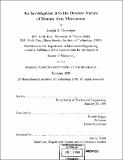An investigation into the discrete nature of human arm movements
Author(s)
Doeringer, Joseph A. (Joseph Alfred)
DownloadFull printable version (20.40Mb)
Advisor
Neville Hogan.
Terms of use
Metadata
Show full item recordAbstract
Human arm movements exhibit a distinct nonsmooth or intermittent character when one engages in visual pointing, visual tracking, or visual tracing of curved shapes. If the intermittency phenomenon could be demonstrated to be part of the arm controller strategy, it would be potentially exploitable as a basis for measuring upper limb performance as well as for estimating the internal states of the arm controller. Before these applications can be addressed, however, it is necessary to determine whether movement intermittency even exists outside of visual feedback tasks. This thesis presents experiments to answer these questions. In one experiment, human subjects were permitted to move only the elbow joint. With and without visual feedback, subjects were asked to (1) move with constant velocity and (2) draw elliptical figures on a phase-plane display (showing elbow velocity vs. position). In both tasks the nonsmooth nature of arm movement was found to be significant, and removal of visual feedback did not significantly change movement intermittency. In another experiment, human subjects were asked to turn a horizontal crank at constant velocity, again with and without visual feedback. Subjects once more were unable to smooth their movements, with significant velocity fluctuations unrelated to crank turning frequency. Despite this, the averaging of several revolutions revealed patterns in velocity as a function of crank angle, patterns that were statistically different between the blind and vision conditions. The predictions of several arm models indicated that a constant speed, constant radius reference trajectory could not account for the patterns of human/ crank behavior. These results demonstrate that movement intermittency is not exclusively due to visual feedback. In addition, it is unlikely that humans command their limbs to move along constant curvature paths in order to interact with constant curvature constraints. Taken collectively, these results suggest that movement intermittency is indeed a fundamental feature of movement behavior and may in fact be a significant part of the limb control strategy.
Description
Thesis (Ph.D.)--Massachusetts Institute of Technology, Dept. of Mechanical Engineering, 1999. Includes bibliographical references (p. 311-327).
Date issued
1999Department
Massachusetts Institute of Technology. Department of Mechanical EngineeringPublisher
Massachusetts Institute of Technology
Keywords
Mechanical Engineering